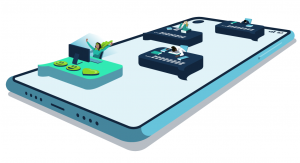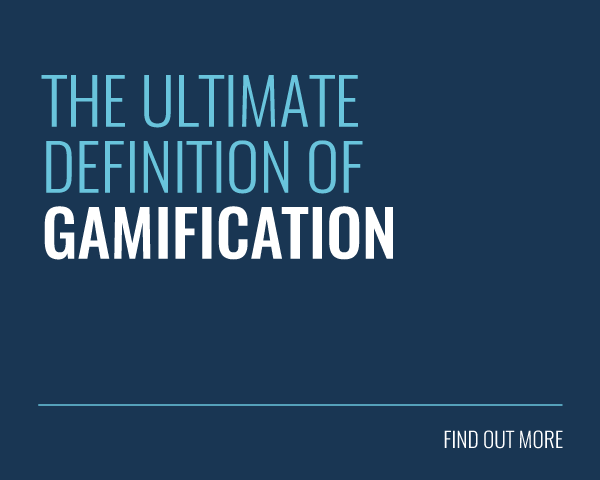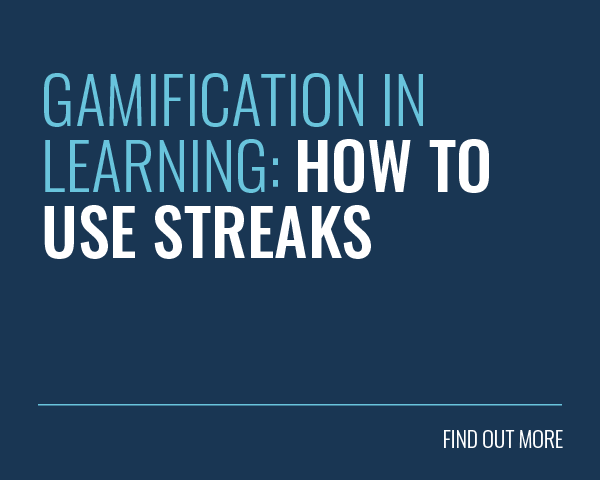 Gamification isn’t going to suddenly explode into a pile of pixels. It’s here to stay. But what does its future look like? Join us as we jump into a DeLorean, reach 88mph and hurtle into a gamified future.
Gamification isn’t going to suddenly explode into a pile of pixels. It’s here to stay. But what does its future look like? Join us as we jump into a DeLorean, reach 88mph and hurtle into a gamified future.
Growth Engineering have been in touch with leading gamification experts from around the world. Each of them have contributed their own unique insight, to help paint a picture of how gamification will evolve and develop over the coming years.
The findings of this report into the future of gamification can be arranged into three main categories.
- Gamification will evolve. If our understanding of gamification doesn’t evolve with it, it will become outdated. An outdated understanding of its capabilities will limit its potential. We mustn’t let this happen.
- The surge in technological innovation will lead to an explosion in new expressions of gamification.
- Further academic research into gamification is essential to its evolution. It will open up new ways to apply the principles of gamification. It will also provide scientific rigour to gamification practice.
This report emphasises the potential of gamification to transform behaviour, business and even society.
Introduction
Gamification may have only received its name in 2002. However, the practice of making everyday tasks fun by making them game-like has been around for millennia.
In the past five years, gamification has changed more than it did in the 1,000 years preceding them. The standard ( yet still effective!) practice is to apply game mechanics such as points, badges and leaderboards. But now, it is increasingly becoming something extraordinary.
Particularly, the next two, five, even ten years will see even more substantial changes. As technology advances at an exponential rate, the evolution of gamification will leap forward.
Peering into what the future of gamification holds is no small feat. Nonetheless, we’ve gathered seven gamification experts who took up the challenge.
In this report, you’ll benefit from their unique insight. Each expert adds their own piece to the puzzle. As these pieces come together, this would create a picture of what the future holds.
Meet the Experts
Craig Mills: Craig was the Learning Manager at GAME, the UK’s largest video games retailer. His passion for gamification is undeniable. His expertise helped GAME deliver gamified training to thousands of employees, winning loads of awards along the way.
Dr. Marigo Raftopoulos: Marigo is a digital media expert. She works with games and gamification, to facilitate enterprise innovation and development. She has a global presence, having been published in peer-reviewed journals and spoken at global events. Her research has added scientific rigour to gamification practice.
Vasilis Gkogkidis: Vasilis is a gamification trainer working for GAMIFICATION+ LTD. Secondly, he is an organiser of Gamification Europe and a Lego Serious Play facilitator. He is also a PhD researcher at the University of Sussex where he researches gamification, innovation and crowdsourcing.
Rob Alvarez: Rob, AKA Professor Game is an expert, speaker and advocate for the use of gamification in education. He’s the creator and host of the Professor Game podcast. In addition, he works at IE Business School Publishing. His focus is on interactive and engaging learning experiences.
Dr. David Chandross: David teaches at Ryerson University and is also the lead game designer/researcher at Game and Train. David also works closely with Sim-ONE, Canada’s healthcare simulation network. He is proud to have contributed to the gamification of addiction medicine, funded by the College of Family Physicians of Ontario.
Juliette Denny: Juliette Denny is the Ideologist in Chief of Growth Engineering. She’s also a GameFed member, a world-renowned speaker and an industry pioneer. Her thought leadership approach wages war on dull online learning. In fact, gamification is the #1 weapon in her arsenal.
Craig Mills: The Future of Gamification in L&D
Gamification & GAME

Gamification is not a new concept for GAME. As you might expect, we immerse ourselves in the latest trends and hype for all the popular gaming experiences.
Our employees’ development thrives because of a gamified LMS. Our employees are passionate gamers who are hungry for the most engaging experience. Above all, we see the need to be thinking of the future at all times.
Gamification in HR
There is a need for gamification to be embedded in HR practices. Such things include values, purpose, personal development, coaching, and recognition. This is something businesses have struggled with. They all stand to benefit from the competitive and engaging nature of gamification.
Imagine a world where you can create a selection of competencies, linked to specific targets upon completion of content. As your learners complete their learning, they can see their stats progressing! This leads to levelling up. Specialist titles would be unlocked as they reach milestones. Then learners can boast about this on their profile. You can ask people skilled in a certain area for support. Similarly, you can give advice to someone in an area you are proficient in!
Everyone loves collecting things. But collecting an endless supply of badges can quickly lose its impact. As such, this element is ready to evolve into something more. Skill-specific badge collections, timed and themed collections, and a recognition system are great incentives. This would really help gamification to maintain its impact over time.
The Future
We need to move beyond the gamification of learning. Clearly, we need to move towards the gamification of behaviours and practice in business.
Our learners are looking for all these features and more. They expect them to be delivered via a mobile user-friendly platform. Particularly, such a platform will likely include push notifications, challenges and events. Furthermore, it can also include a detailed dashboard for you to view your progress and compare it with others.
In other words, gamification is popular now but this is nowhere near the level of popularity the future holds.
Marigo Raftopoulos: Strategic Gamification
What Will Gamification Look Like in the Future?
In the future, gamification will be a strategic management tool rather than a simple solution of game-based design features.
Gamification will be about how we think, how we collaborate, and how we co-create a different way of learning and building a community.
How will Gamification have changed?
Gamification’s development to date has been dominated by a focus on technology and gameful-design. But now, it’s evolving into a more substantial science that’s backed by rigorous research. Specifically, these are theories and frameworks that can be applied across a broad range of applications. Hence, this represents a shift in focus from short-term tactical solutions to long-term strategic development.
How Will Gamification Affect People’s Lives?

Strategically focused gamification will rely less on behavioural design elements. It will lean more towards building human agency, autonomy and capability. This means that we empower people in a meaningful way rather than nudge, push, entice and reward. The latter just makes people a little happier about the current system. It doesn’t empower them to change the system.
The Relationship Between Gamification and Innovation
Gamification has provided an innovative approach to existing solutions. However, it is limited in its capability to develop innovative outcomes that could drive paradigm shifts and problem-solving. This is a subtle but important difference.
Hence, the most significant (social, economic, environmental) challenges we face are those requiring systemic change and managing complexity. Clearly, this will require a different type of gamification than the one we know.
Vasilis Gkogkidis: Gamification: An Art and a Science
Community-Based
I believe that the future should be community-based. There is a lot of value in people getting together, in sharing knowledge and best practice. For gamification to survive, we need to come together, compare notes and talk to each other regularly.
Opportunities
There is a lot to be improved in learning, HR and team building. I am also interested in gamification for innovation – a relatively new field of practice and research.
There is a big opportunity for people who want to research gamification projects. Currently, there is not enough research, nor are there enough books that document case studies in an organised and analytical way.
Technologies

AR will be used a lot in gamification (VR will work better for games and completely immersive experiences). In fact, it already boasts some interesting uses in gamification projects.
Specifically, cloud-based solutions are already the norm in any gamification system.
But I would like to see more analogue and face-to-face gamification in offices and workplaces. When we engage people face-to-face and ask them to make something without a computer in front of them, we see exciting results!
The convergence of Academia and Industry
Gamification is part art, part science.
The industry needs to do more reading, and academia needs to do more practice (and work closer to the industry). The industry can discover case studies that academics have been documenting and explaining from a scientific point of view. Furthermore, Academics should document and research more projects more directly connected to the industry.
Rob Alvarez: An Invitation to Gamification
The Sneakiness of Gamification
Gamification has been quite sneaky in the years after the hype. What used to be on many people’s bios and many company’s descriptions is no longer there. This could mean it is dying out, but many of the key lessons of gamification have continued. What’s more, it has even increased to be applied in many circumstances.
This is where it gets interesting. These strategies and ideas have started to sprout into projects, products, classrooms and many other places, even without the intent of gamified design.
A Challenge and an Invitation
This brings forth a new challenge for the future: How do we spot these situations and make them intentional, with the simple goal of making them radically more effective?
The same happened 20 years ago when loyalty programs had a lot of room for improvement. The difference is that we are now aware of how games are able to motivate us. We have been intentionally creating engagement through its strategies. The natural thing is that those who are in the field will get better and discover new things with practice.
As always, there is an invitation to be constantly aware of the opportunities that gamification has to offer. An invitation to be aware of what it can offer your work. An invitation for practice so you get better. More importantly, to become part of the growing team of gamification practitioners around the world!
David Chandross: A Gamified Life
Gameworlds
 The principal shift in gamification will be the construction of open gameworlds. These are 3D, immersive locations that players can explore. We are already building these at Baycrest Health Sciences in Toronto, Ontario.
The principal shift in gamification will be the construction of open gameworlds. These are 3D, immersive locations that players can explore. We are already building these at Baycrest Health Sciences in Toronto, Ontario.
Open gameworlds will become the cutting edge of education technology. It will provide unsurpassed ability to monitor learner progress. Moreover, it can set goals which encourage content exploration, social connectedness, competition or achievement.
Moreover, smart learning-game apps will continue to provide moment to moment feedback to both students and instructors using course analytic software. This will enable educators to assess knowledge through measurement of player behaviours and decision-making in virtual space.
Virtual Space
Virtual space will be created through advances in laser scanning and 3D game-world building technology. In short, you will live in two worlds, the real one, and a virtual one which archives your data for professional or personal use.
Virtual reality experiences will be designed to integrate with game mechanics and learning outcomes. Specifically, this will create a continuous learner experience through achievements, badges and controlled challenges.
Gamified experiences will radically improve skill acquisition, motivation, engagement and learner achievement tracking. Gameworld designs will replace conventional presentation media. This is in order to enable precision in training with the goal of skill rehearsal. Accordingly, this will enable learners to identify target behaviours associated with success.
Authentic alignment will drive learning in all technologies, backed by evidence-driven coaching and mentoring support.
I view the future of gamification as an integration of learning with job and life “performance” using small head-mounted displays and other biologically integrated systems. This will permit gamification technologies to be used for behavioural change. Such include addiction management, fitness and even psychological support.
Juliette Denny: The Engagement Engine
Gamification + social features + personalisation = unstoppable engagement. Gamification implemented properly is social and personalised. These three ideas are so interwoven it’s impossible to separate them.
Let’s take a peek at how the future will look as gamification becomes more socially connected and more personalised.
Gamification and Personalisation

Humans are extraordinary. We’re a species of skydivers, roundabout enthusiasts, stamp collectors and astronauts. What makes one person punch the air in excitement might cause another to hide behind their hands.
It’s the same with gamification. Where one person is desperate to win rewards, others need encouragement, or crave the freedom to explore.
Right now, gamified software doesn’t learn which stimuli each user responds to, but the technology already exists. At Growth Engineering, we’re investigating how we can use machine learning to train gamification software. This is in order for us to get to know each user personally.
Gamification software will be able to understand each user and provide them with a tailored experience. The experience will be designed to engage them specifically.
Social Gamification
You might find it hard to imagine the world more connected than it is today. Yet every few years, a new innovation comes along and the world gets that bit smaller. Think Telegrams, telephones, texting, the internet…
Our lives are getting increasingly interconnected. Connectedness isn’t just about staying in touch with old friends. It’s about problem-solving. Crowdfunding and crowdsourcing have proven that. They enables us to come together so we can overcome problems that can’t be overcome alone.
When people come together to solve problems and overcome challenges, they become part of something greater than they are on their own.
This sense of purpose, (which I call Epic Meaning), is an important game mechanic. It gives people the drive they need to change the world. Combine that with the problem-solving power of a connected world, and gamification could well be the tool we use to solve our greatest problems.
The Engagement Engine of the Future
There are those who describe gamification as a lonely and isolated experience. There are those who think that a one-size-fits-all approach is the future.
But the future of gamification is social and personalised.
Disengagement is the root of many problems we face today. Gamification will solve these problems by bringing people together, empowering them with purpose, and engaging them with stimuli that work specifically for them. In the future, gamification will have the power to overcome any obstacle. It will be able to solve any problem and engage the world.
Key Findings
-
-
-
People will be able to use gamification to shape their skills and behaviours. This would allow them to become the person they want to be.
-
Technology will open up new opportunities for gamification practitioners. Augmented reality, virtual reality, head-mounted displays, machine learning, biologically integrated systems and game worlds all hold enormous potential.
-
Gamification is still in its infancy. As it enters maturity, gamification practice needs to be supported by further research. Gamification practitioners also need to work more closely with researchers. Particularly, they need to collaborate in order to increase the body of research literature related to gamification.
- At present, gamification is seen as a solution for combating disengagement. In the future, it will be used as a tool for facing ‘the most significant social, environmental and economic challenges’.
-
-
Final Words
Based on the extravagance of these gamification predictions, you might assume they’re predicting the distant future or that they’re long-shot suggestions. But they’re not.
Many of the predictions in this report are within touching distance. Some of the contributions describe innovations that have already happened. They’re just waiting for wider uptake.
No one can know what the future will look like. But this report arms you with the insight you’ll need to inform your decisions and incorporate gamification into your business strategy.
Staying ahead of the curve is important. But it’s even more important to be inspired. Gamification has the potential to help solve problems, from individual behaviour change to global issues. Don’t let your preconceptions about gamification limit your goals!








